
The First Championship
The first NCAA track & field championship was also the first championship conducted in any sport by the NCAA, and the significance of the event started at the top. Amos Alonzo Stagg chaired the committee which oversaw that first contest, whose referee was none other than Gen. Palmer E. Pierce, the first president of the NCAA.
Some newspapers even dubbed the event the “American Olympics” as entries came from all regions of the country and included notable stars from the 1920 Olympics.
That first meet took place on June 18, 1921, at Amos Alonzo Stagg Field on the campus of the University of Chicago. The site was primarily used for football, but had also staged some AAU national track & field championships, including the 1893 meet in its inaugural year of use (It was known then as Marshall Field).
A light rain fell before the meet started on Saturday at 2 p.m. with field events, followed by heats of the 120-yard hurdles 15 minutes later. The longest race was the 2-mile, there were no relays, and all of the current field events were held except the triple jump. There were 113 competitors from 62 institutions, half of which scored by placing individuals in the top-5 and given points on a 5-3-2-1-½ basis.
Illinois (20¼ points) won the meet without having a single event champion, but saw nine athletes score in 10 of the 15 events. One of the Illini’s top athletes was Harold Osborn, who scored in the high jump and long jump (Osborn would win Olympic gold medals in the long jump and decathlon three years later and remains the only athlete to ever win Olympic golds in both the decathlon and an individual event).
Notre Dame – one of just two programs to win two events – was runner-up with 16¾ points. The Irish had Gus Desch win the 220-yard hurdles and Johnny Murphy claim the high jump. The previous year, Desch was a bronze medalist in the 400-meter hurdles at the Olympics, while Murphy was fifth in the high jump.
Washington was the other program to win two events, courtesy of Gus Pope, who swept the shot put and discus. He became the meet’s first double winner (Pope was bronze medalist in the 1920 Olympic discus).
The biggest individual star was 1920 Olympic gold medalist Earl Thomson of Dartmouth, who equaled his own world record in the 120-yard hurdles of 14 2/5 (Watches were only accurate to a fifth of a second back then). His world record would not be bettered until 1931.
The meet was a homecoming for Earl Eby of Penn. The native of Aurora, Ill., went to high school in Chicago and won the 880 yards in his final collegiate competition. He was silver medalist in the 1920 Olympics and helped Penn win the team title at the 1920 IC4A Championships.
The NCAA and collegiate track & field will mark a momentous milestone in the spring of 2021 -- the 100th anniversary of the NCAA Championships and with that, the NCAA Track & Field Championships. In June 1921, the University of Chicago hosted the first track & field championships in NCAA history.
This point can’t be emphasized enough: Not only was the event the first for NCAA track & field, but the first championships for any sport under the sponsorship of the NCAA.
To celebrate, over each of the next 365 days, the U.S. Track & Field and Cross Country Coaches Association (USTFCCCA) will celebrate moments, student-athletes, and coaches that have made a century’s worth of championships special. From humble beginnings to important historical milestones to the modern-day, collegiate track & field has evolved with the American society.
The 2021 edition of the NCAA Division I Outdoor Track & Field Championships begin with preliminary round action on May 27-29 in Jacksonville, Fla., and College Station, Texas. The championships final site and culmination of the celebration is slated for June 9-12, 2021 at the newly rebuilt Hayward Field in Eugene, Ore.
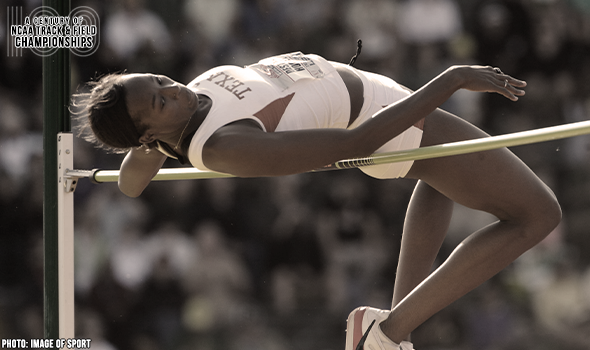
Texas’ Hooker High Jumped To NCAA Glory
Destinee Hooker won three career high jump titles at the NCAA DI Outdoor T&F Championships, including a massive victory in 2009 by more than two inches.
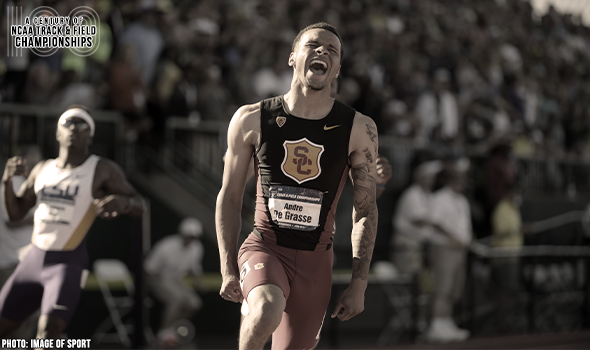
De Grasse Sprinted To Otherworldly Double
Andre De Grasse completed the 100-200 double at the 2015 NCAA DI Outdoor T&F Championships with scorching times: 9.75 (+2.7) in the 100; 19.58 (+2.4) in the 200.
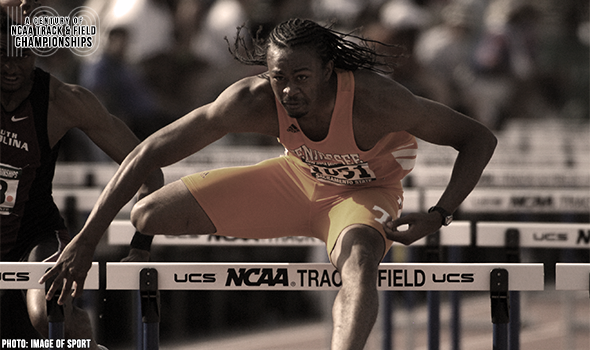
Merritt Broke Long-Standing 110H MR In 2006
Aries Merritt broke a 28-year-old meet record in the 110H when he won the crown at the 2006 NCAA DI Outdoor T&F Championships in 13.21.
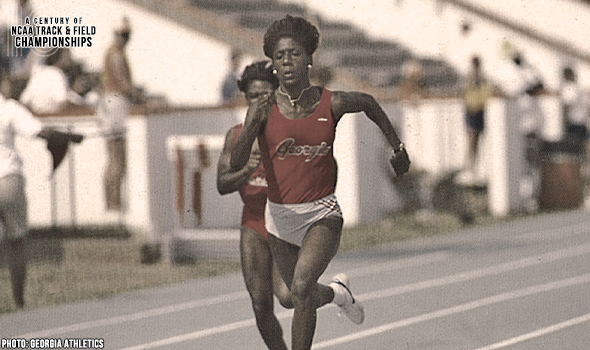
UGA’s Torrence Made NCAA History With Double
Gwen Torrence completed the 100-200 double at the 1987 NCAA DI Outdoor T&F Championships. Torrence was also the first woman to finish top-8 four times in the 100.
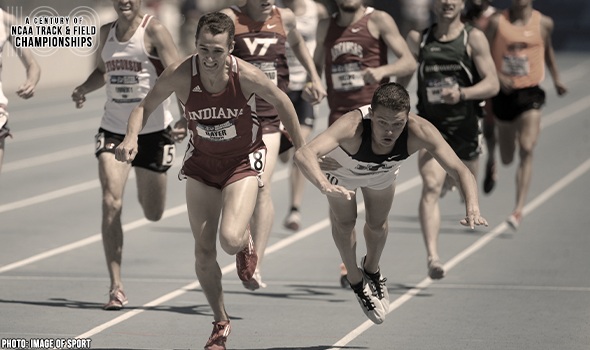
Bayer Gave It His All For NCAA 1500 Title
Andrew Bayer won the 1500 at the 2012 NCAA DI Outdoor Track & Field Championships in one of the closest finishes in meet history – 0.01 seconds.

Tipton Led 1-2-3 Oregon Finish In 1964 JT
Les Tipton led the first podium sweep of any event in the history of the NCAA Outdoor T&F Championships. Tipton and his Oregon teammates went 1-2-3 in the 1964 javelin.

K-State’s Jones Captured Heptathlon Crown In 2015
Akela Jones won the heptathlon at the 2015 NCAA DI Outdoor T&F Championships with 6371 points. That is the fourth-best score in both collegiate history & meet history.

Same Athletes, Same Result For LSU At NCAAs
The LSU foursome of Bennie Brazell, Pete Coley, Robert Parham, Kelly Willie swept the 4×100 & 4×400 crowns at the 2003 NCAA DI Outdoor T&F Championships.

Martin Won Distance Titles For Two Programs
Francis (Frank) Martin made history twice in the NCAA Outdoor Track & Field Championships.

FSU’s Williams Soared To Jumps Double In 2009
Kim Williams swept the horizontal jumps at the 2009 NCAA DI Outdoor T&F Championships. Williams was particularly dominant in the TJ, winning at 14.38m (47-2¼) & by nearly 2 feet.

